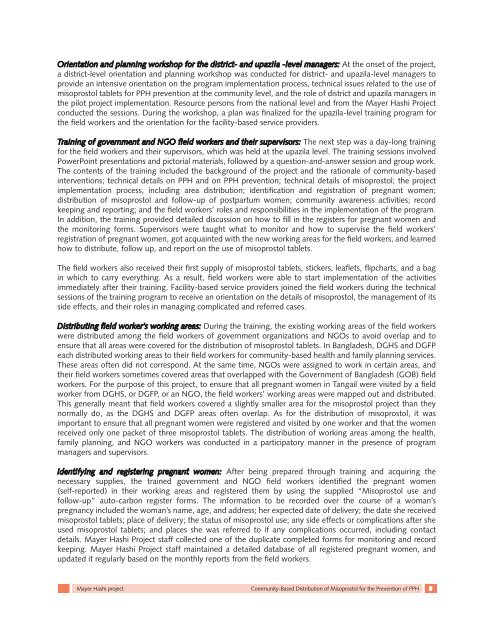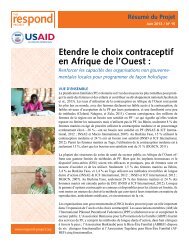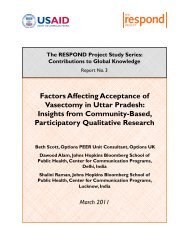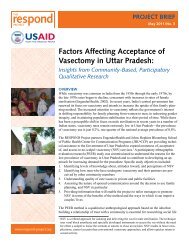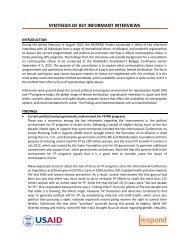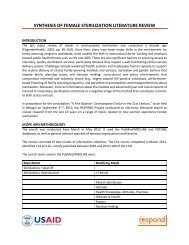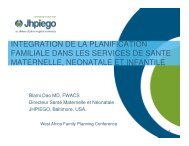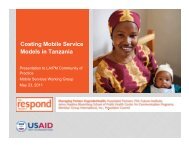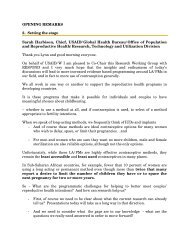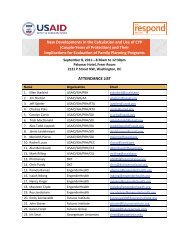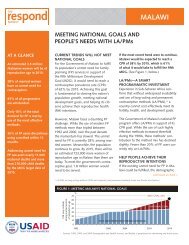Community-Based Distribution of Misoprostol for the Prevention of ...
Community-Based Distribution of Misoprostol for the Prevention of ...
Community-Based Distribution of Misoprostol for the Prevention of ...
You also want an ePaper? Increase the reach of your titles
YUMPU automatically turns print PDFs into web optimized ePapers that Google loves.
Orientation and planning workshop <strong>for</strong> <strong>the</strong> district- and upazila -level managers: At <strong>the</strong> onset <strong>of</strong> <strong>the</strong> project,<br />
a district-level orientation and planning workshop was conducted <strong>for</strong> district- and upazila-level managers to<br />
provide an intensive orientation on <strong>the</strong> program implementation process, technical issues related to <strong>the</strong> use <strong>of</strong><br />
misoprostol tablets <strong>for</strong> PPH prevention at <strong>the</strong> community level, and <strong>the</strong> role <strong>of</strong> district and upazila managers in<br />
<strong>the</strong> pilot project implementation. Resource persons from <strong>the</strong> national level and from <strong>the</strong> Mayer Hashi Project<br />
conducted <strong>the</strong> sessions. During <strong>the</strong> workshop, a plan was finalized <strong>for</strong> <strong>the</strong> upazila-level training program <strong>for</strong><br />
<strong>the</strong> field workers and <strong>the</strong> orientation <strong>for</strong> <strong>the</strong> facility-based service providers.<br />
Training <strong>of</strong> government and NGO field workers and <strong>the</strong>ir supervisors: The next step was a day-long training<br />
<strong>for</strong> <strong>the</strong> field workers and <strong>the</strong>ir supervisors, which was held at <strong>the</strong> upazila level. The training sessions involved<br />
PowerPoint presentations and pictorial materials, followed by a question-and-answer session and group work.<br />
The contents <strong>of</strong> <strong>the</strong> training included <strong>the</strong> background <strong>of</strong> <strong>the</strong> project and <strong>the</strong> rationale <strong>of</strong> community-based<br />
interventions; technical details on PPH and on PPH prevention; technical details <strong>of</strong> misoprostol; <strong>the</strong> project<br />
implementation process, including area distribution; identification and registration <strong>of</strong> pregnant women;<br />
distribution <strong>of</strong> misoprostol and follow-up <strong>of</strong> postpartum women; community awareness activities; record<br />
keeping and reporting; and <strong>the</strong> field workers’ roles and responsibilities in <strong>the</strong> implementation <strong>of</strong> <strong>the</strong> program.<br />
In addition, <strong>the</strong> training provided detailed discussion on how to fill in <strong>the</strong> registers <strong>for</strong> pregnant women and<br />
<strong>the</strong> monitoring <strong>for</strong>ms. Supervisors were taught what to monitor and how to supervise <strong>the</strong> field workers’<br />
registration <strong>of</strong> pregnant women, got acquainted with <strong>the</strong> new working areas <strong>for</strong> <strong>the</strong> field workers, and learned<br />
how to distribute, follow up, and report on <strong>the</strong> use <strong>of</strong> misoprostol tablets.<br />
The field workers also received <strong>the</strong>ir first supply <strong>of</strong> misoprostol tablets, stickers, leaflets, flipcharts, and a bag<br />
in which to carry everything. As a result, field workers were able to start implementation <strong>of</strong> <strong>the</strong> activities<br />
immediately after <strong>the</strong>ir training. Facility-based service providers joined <strong>the</strong> field workers during <strong>the</strong> technical<br />
sessions <strong>of</strong> <strong>the</strong> training program to receive an orientation on <strong>the</strong> details <strong>of</strong> misoprostol, <strong>the</strong> management <strong>of</strong> its<br />
side effects, and <strong>the</strong>ir roles in managing complicated and referred cases.<br />
Distributing field worker’s working areas: During <strong>the</strong> training, <strong>the</strong> existing working areas <strong>of</strong> <strong>the</strong> field workers<br />
were distributed among <strong>the</strong> field workers <strong>of</strong> government organizations and NGOs to avoid overlap and to<br />
ensure that all areas were covered <strong>for</strong> <strong>the</strong> distribution <strong>of</strong> misoprostol tablets. In Bangladesh, DGHS and DGFP<br />
each distributed working areas to <strong>the</strong>ir field workers <strong>for</strong> community-based health and family planning services.<br />
These areas <strong>of</strong>ten did not correspond. At <strong>the</strong> same time, NGOs were assigned to work in certain areas, and<br />
<strong>the</strong>ir field workers sometimes covered areas that overlapped with <strong>the</strong> Government <strong>of</strong> Bangladesh (GOB) field<br />
workers. For <strong>the</strong> purpose <strong>of</strong> this project, to ensure that all pregnant women in Tangail were visited by a field<br />
worker from DGHS, or DGFP, or an NGO, <strong>the</strong> field workers’ working areas were mapped out and distributed.<br />
This generally meant that field workers covered a slightly smaller area <strong>for</strong> <strong>the</strong> misoprostol project than <strong>the</strong>y<br />
normally do, as <strong>the</strong> DGHS and DGFP areas <strong>of</strong>ten overlap. As <strong>for</strong> <strong>the</strong> distribution <strong>of</strong> misoprostol, it was<br />
important to ensure that all pregnant women were registered and visited by one worker and that <strong>the</strong> women<br />
received only one packet <strong>of</strong> three misoprostol tablets. The distribution <strong>of</strong> working areas among <strong>the</strong> health,<br />
family planning, and NGO workers was conducted in a participatory manner in <strong>the</strong> presence <strong>of</strong> program<br />
managers and supervisors.<br />
Identifying and registering pregnant women: After being prepared through training and acquiring <strong>the</strong><br />
necessary supplies, <strong>the</strong> trained government and NGO field workers identified <strong>the</strong> pregnant women<br />
(self-reported) in <strong>the</strong>ir working areas and registered <strong>the</strong>m by using <strong>the</strong> supplied “<strong>Misoprostol</strong> use and<br />
follow-up” auto-carbon register <strong>for</strong>ms. The in<strong>for</strong>mation to be recorded over <strong>the</strong> course <strong>of</strong> a woman’s<br />
pregnancy included <strong>the</strong> woman’s name, age, and address; her expected date <strong>of</strong> delivery; <strong>the</strong> date she received<br />
misoprostol tablets; place <strong>of</strong> delivery; <strong>the</strong> status <strong>of</strong> misoprostol use; any side effects or complications after she<br />
used misoprostol tablets; and places she was referred to if any complications occurred, including contact<br />
details. Mayer Hashi Project staff collected one <strong>of</strong> <strong>the</strong> duplicate completed <strong>for</strong>ms <strong>for</strong> monitoring and record<br />
keeping. Mayer Hashi Project staff maintained a detailed database <strong>of</strong> all registered pregnant women, and<br />
updated it regularly based on <strong>the</strong> monthly reports from <strong>the</strong> field workers.<br />
Mayer Hashi project <strong>Community</strong>-<strong>Based</strong> <strong>Distribution</strong> <strong>of</strong> <strong>Misoprostol</strong> <strong>for</strong> <strong>the</strong> <strong>Prevention</strong> <strong>of</strong> PPH 5


